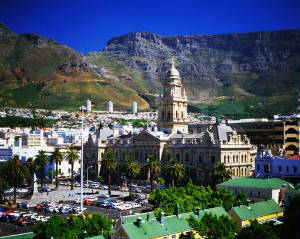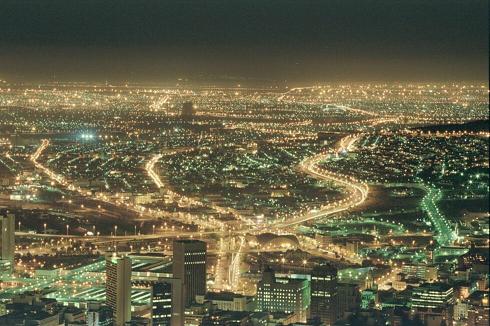|
CAPE TOWN UNDER THE SPOTLGHT
# Workforce: Cape Town's work-force, at a little over 1.3 million, is comparable to Seattle, Washington or Baltimore, Maryland,
and a full third higher than Vancouver, Canada. Its unemployment rate is the lowest of the three major cities in South Africa.
# Skills: Cape Town's proportion of degreed people exceeds any other city in South Africa by a fair margin. It is estimated
that Cape Town has more computers per 1 000 people than any city in South Africa, and exceeds Bangkok, Buenos Aires, Rio de
Janeiro, Santiago, St Petersburg or Warsaw. Further estimates indicate that it has more internet connections per 1 000 people
than any city in South Africa, and exceeds Bangkok, Buenos Aires, Kuala Lumpur, Moscow, Rio de Janeiro or Santiago.
# Professionalism: Cape Town's professional or managerial employment as a percentage of the worklorce is higher than Miami,
New York, San Diego or Richmond, and is marginally under the US average of 25.2%.
# Education: Cape Town spends more on education as a percentage of GNP than Athens, HongKong, Melbourne, Manila, Singapore
or Seoul.
# Government employment: Cape Town's proportion of the workforce employed by government is beneath the US average of 15.7%,
despite the fact that parliament is based in Cape Town. It also exceeds Boston, Seaffle, New York, Charlotte, North Carolina
and Cleveland, Ohio.
# Safety: Cape Town's crime rate in the wider metropole is comparable to New York or Los Angeles. At city centre level,
a joint, zero-tolerance effort by the private sector and city council has now brought the central city more into line with
international norms.
# Pollution: Cape Town is a relatively clean air city and has fewer bad air days than Atlanta, Baltimore, Charlotte, Los
Angeles, Dallas, New Orleans or Sacramento, amongst many others, especially Houston.
# Price of property: despite its superior quality of life, Cape Town is amongst the cheapest cities anywhere in the world
to buy or rent property in dollar terms (and at the time the study was conducted, the rand was still 8:1). Average A-grade
rentals in Cape Town's central city' and for that matter most of the business districts in South Africa are considerably
less costly than any North American, Latin American or European city, and are competitively below most emerging economy cities.
The World Competitiveness Yearbook in fact rated us first of the 47 countries it investigated.
# Growth and prospects: Cape Town&'s real GDP growth in 1999 was comparable to the city average for New Zealand,Hong
Kong and the Philippines. Its forecast growth rate for 2002 is 3.5-4%
# Global business environment: using the Arthur Andersen/Fortune measure, Cape Town's Business Environment Score is higher
than Buenos Aires, Rio de Janeiro, Kuala Lumpur, Manila or Prague, and is comparable to Lisbon, Rome or Tokyo.
# Cost of living index: Cape Town comparable to Kuala Lumpur and Madrid. It is easily more competitive than most major
cities in the world, but particularly more so than Buenos Aires, Jakarta, Istanbul, Moscow, Warsaw, Singapore or Taipei.
# Entrepreneurial: Cape Town creates proportionally more new firms than most major cities. In terms of its propensity
to create new companies, it typically exceeds Amsterdam, Bangkok, Barcelona, Brussels, Buenos Aires, Manila, Moscow, Paris,
Singapore, Vienna or Zurich.
# Risk: Cape Town's composite economic, political and financial risk rating is better than any other city in South Africa,
and is comparable to Manila, and better than Brasilia, Jakarta, Moscow or Rio de Janeiro.
# Economic freedom: Cape Town is on a par with Kuala Lumpur, Warsaw or Santo Domingo and is better than Moscow, Manila,
Delhi or São Paulo.
# Inflation: Cape Town's inflation rate remains low and in 1999 was below Budapest, Delhi, Istanbul, Jakarta, Manila,
Moscow, Rio de Janeiro or Warsaw, amongst many others

CAPE TOWN AT A GLANCE
According to tradition, when Portuguese explorer Bartholomew Dias first rounded the Cape in 1488, he named it the Cape of
Storms, in deference to the stormy weather he experienced off the tip of Africa. However, it was quickly renamed Cape of Good
Hope by King John II of Portugal, who believed that they had finally found a sea route to India. Africans in the region have
a different perspective. They call it Ikapa Lodumo (Cape of Fame) because of its attractions as a world class tourist destination.
The Cape is probably best known for Table Mountain, which forms an imposing backdrop to the city. The Table Mountain Reserve
stretches from the city, right down to Cape Point.
The Cape is famous for its winelands, which produce some of the finest wines in the world. Stellenbosch, Franschoek and
Paarl are probably the best known names, but there are also a host of smaller towns that are well worth exploring.
The spectacular Atlantic Seaboard is definitely South Africa's riviera, playground of the rich and famous. It also boasts
some of the finest beaches in the southern hemisphere.
Cape Town is affectionately known as the "Mother City", a reflection of its status as the oldest city in South
Africa, and its warm, open welcome to visitors.
Most of Cape Town's population lives on the Cape Flats, a vibrant and eclectic mix of smallholdings, light industry, shantytowns
and upmarket residential suburbs.
False Bay is home to some of the best swimming beaches in the Cape, the most famous of which is Boulders, just outside
of Simonstown, which comes complete with a colony of jackass penguins.
 |

